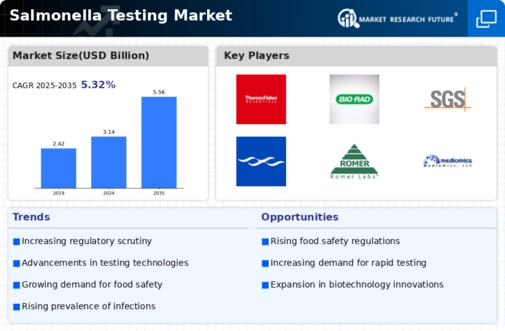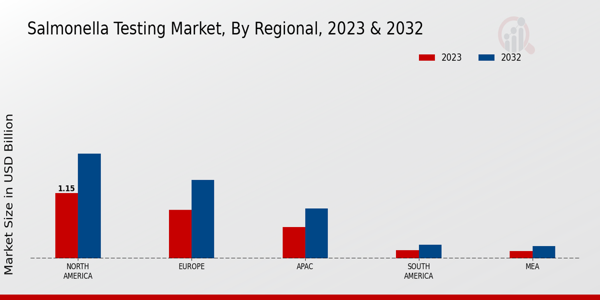Market Growth Projections
The Global Salmonella Testing Market Industry is projected to experience substantial growth over the next decade. With a market size anticipated to reach 3.14 USD Billion in 2024 and further expand to 5.56 USD Billion by 2035, the industry is on a promising trajectory. The compound annual growth rate (CAGR) of 5.33% from 2025 to 2035 indicates a robust demand for Salmonella testing solutions. This growth is driven by various factors, including regulatory pressures, consumer awareness, and technological advancements. The market's expansion reflects the increasing importance of food safety and public health in the global context.
Growing Consumer Awareness
Consumer awareness regarding foodborne illnesses, particularly those caused by Salmonella, is on the rise. The Global Salmonella Testing Market Industry is benefiting from this trend as consumers increasingly demand transparency in food sourcing and safety. Educational campaigns and media coverage of Salmonella outbreaks have heightened public concern, prompting food companies to adopt rigorous testing measures. This shift not only enhances consumer trust but also drives market growth. As awareness continues to expand, the industry is likely to see sustained demand for Salmonella testing solutions, contributing to a projected market size of 5.56 USD Billion by 2035.
Rising Food Safety Regulations
The Global Salmonella Testing Market Industry is experiencing growth due to increasing food safety regulations imposed by governments worldwide. Regulatory bodies, such as the Food and Drug Administration in the United States, have established stringent guidelines for food manufacturers to ensure the safety of their products. This regulatory environment compels food producers to implement robust testing protocols for Salmonella, thereby driving demand for testing services and products. As a result, the market is projected to reach 3.14 USD Billion in 2024, reflecting the heightened focus on food safety and public health.
Emerging Markets and Global Trade
Emerging markets are playing a pivotal role in the growth of the Global Salmonella Testing Market Industry. As countries in Asia, Africa, and Latin America enhance their food safety standards and regulations, the demand for Salmonella testing is expected to rise. Additionally, the expansion of global trade in food products necessitates stringent testing to prevent cross-border contamination. This trend is likely to drive investments in testing infrastructure and services in these regions. The increasing interconnectedness of global food supply chains further emphasizes the importance of Salmonella testing, positioning the market for substantial growth in the coming years.
Expansion of the Food and Beverage Industry
The continuous expansion of the global food and beverage industry is a key driver for the Global Salmonella Testing Market Industry. As food production scales up to meet growing consumer demand, the risk of Salmonella contamination also increases. This necessitates comprehensive testing protocols to ensure food safety and compliance with regulations. The market is poised for growth as manufacturers invest in Salmonella testing to protect their brands and consumers. The increasing number of food processing facilities worldwide further underscores the need for effective testing solutions, contributing to the market's projected growth.
Technological Advancements in Testing Methods
Innovations in testing technologies are significantly influencing the Global Salmonella Testing Market Industry. Advanced methodologies, such as polymerase chain reaction (PCR) and next-generation sequencing, offer rapid and accurate detection of Salmonella in food products. These technological advancements reduce testing times and improve reliability, making them attractive to food manufacturers. As companies seek to enhance their testing capabilities, the adoption of these technologies is expected to increase, thereby propelling market growth. The ongoing evolution of testing methods suggests a robust market trajectory, with a projected CAGR of 5.33% from 2025 to 2035.














